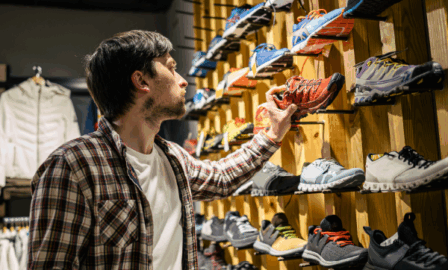2024 Apparel Industry Trends
Read our updated trends report here: 2025 Apparel Industry Trends
Clarkston’s team of apparel consultants have highlighted the top apparel industry trends that businesses should consider. Read all 5 trends for 2024 by downloading the full report here.
The retail industry is a continuously evolving landscape that has changed over the past three years with both a pandemic and increasing cost of goods sold, making it more difficult for companies to predict what customers want or when they want their products. The apparel industry, in particular, has had some of the most significant shifts in what the consumer wants – driven, in part, by economic uncertainty – and has provided great insight into how quickly shopper interests can change.
As the apparel industry changes daily, a few key themes stand out above all others. Sustainability is not just a trend; it’s becoming a lifestyle for many customers. People are interested in purchasing eco-friendly apparel – less to feel some sense of personal accomplishment but more to truly help the environment in any way they can. Customers are also looking to change not only how their apparel is made but also the form in which they are buying it. Alternative channels of purchase, such as eCommerce and social platforms, have begun to take over, and shoppers have become increasingly more interested in entirely customizable apparel/shopping experiences.
Even with a few hurdles, such as rising inflation, luxury apparel is also making a resurgence, but this time without the large, flashy logos and vibrant colors. Shoppers are leaning back toward “inconspicuous consumption” and want apparel for its refined elegance rather than its boisterous appearance. As inflation and other economic inefficiencies over the last few years have led to a higher Cost of Goods Sold (CoGS), apparel brands must find innovative solutions to combat potential threats to their business. In this report, we dive into key 2024 apparel industry trends and their impact on retailers moving forward.
2024 Apparel Industry Trends
Trend #1: Opportunities in Sustainability
One of the most profound trends in the apparel industry today is the continued emphasis on sustainability, whether in the supply chain or manufacturing. Shoppers still demand sustainable apparel. The “fast fashion” days of yesterday are again being replaced by an influx of shoppers looking to find a more ethical, eco-friendly, and less guilty form of fashion. Sustainability in apparel comes in various styles, whether it’s Adidas’s recycled shoe collaboration with Parley, or the customer choosing to wait a bit longer for their package to arrive if that means reduced emissions.
We know these sustainability initiatives are important to shoppers, with one study stating that 37% of customers would mainly consider a product’s environmental impact before purchasing. It’s perhaps even more crucial to note that 73% of Millennials said they prefer to purchase from sustainable brands — a group of shoppers who, combined with Gen Z, currently hold the highest level of buying power out of any group in the US economy.
With this in mind, companies have started considering more efficient and cleaner shipping and packaging methods. We’re also starting to see some impressive commitments to change, like the recent initiative targeting greater supply chain sustainability – the International Maritime Organization (IMO) 2023, which “aims to reduce shipping carbon emissions by 40% by 2030, and 70% by 2050 compared to 2008 levels.”
There are different ways a shipping company can reduce costs. Still, the most common practices begin with slow steaming (the strategic deceleration of a cargo ship to reduce fuel burn rate) and route optimization (finding the route with the clearest weather with the shortest distance traveled). No matter the option, as we look into 2024 and beyond, it will be essential for retailers and suppliers alike to further their sustainable practices within their organization to ensure a longer-lasting, adaptive, and more competitive business model – one that meets both industry and customer expectations for sustainability.
Download the Full 2024 Apparel Industry Trends Report Here
Trend #2: Fully Customizable Apparel
Fully customizable apparel has been around in the apparel industry for decades; monogrammed shirts, tailored suits, and custom shoes are all examples. We’ve seen box retailers like Nordstrom capitalize on the upward trend of full customization by including free tailoring with all their pants and shirts upon purchase. While this is a common example of what fully customizable apparel may be, technology takes this to a whole new depth and creates a user experience unparalleled by anything seen in the retail world previously.
Fully customizable apparel has been able to utilize artificial intelligence (AI) to determine what each customer is interested in and directly advertise or sell to the individuals. Customers are more willing to share their info online and utilize platforms such as Google ad services, and one report shows that “83% of consumers are willing to share their data for a more personalized experience.”
Subscription-based business models are successfully implementing this capability as well; a shopper can go online, click a few buttons, and have a completely personalized and curated collection of apparel show up at their door as frequently as they would like. Adding a similar business model to any retail business will help add value and diversity, ultimately drawing in new customers, as they will have a more streamlined and personalized shopping experience. This personalized experience can help build brand loyalty, improve customer satisfaction, and ultimately ensure that your shoppers remember your business.
3D printing has also made apparel much more customizable for a reasonable price difference, creating many opportunities for retailers like Adidas to offer customized soles to their customers. One report shows that 3D printing revenues are expected to reach nearly $35 billion by 2028. This means that fully customizable apparel has the potential to be a dominant force in the apparel market over the next several years. As such, companies that can harness the power of 3D printing will create more opportunities and succeed in meeting the growing trend of fully customizable apparel. Continue reading by downloading the full report below.
Download the Full 2024 Apparel Industry Trends Report Here
Read last year’s Apparel Industry Trends Report here.
Subscribe to Clarkston's Insights
Contributions from Michael Gallagher and Sara Kayhan



